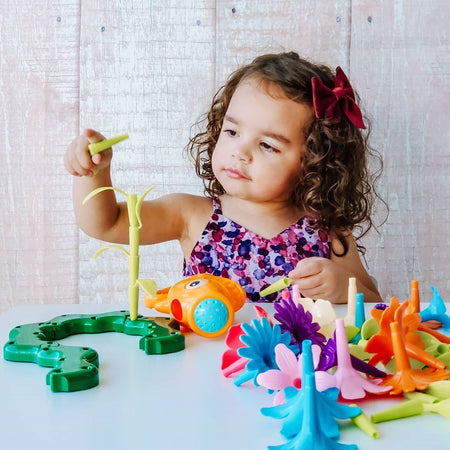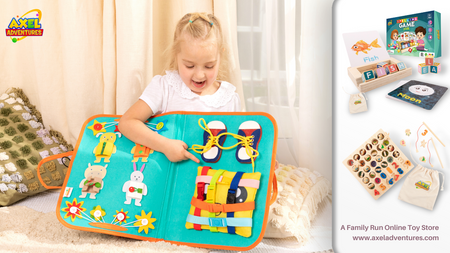
Are you searching for ways to enhance your child's development while providing them with hours of entertainment? Look no further than sensory play!
This captivating and educational approach to learning offers numerous benefits for children of all ages. In this comprehensive guide, we'll delve into the exciting world of sensory play, its importance, and how it can positively influence your child's cognitive, emotional, and physical development.
The Power of Sensory Play: Enhancing Your Child's Development
Sensory play is not just about having fun—it's a crucial aspect of your child's overall development. By engaging their senses, sensory play stimulates neural pathways, enhances cognitive abilities, and fosters essential skills. Let's explore the key benefits of sensory play and discover why it's a must for every child:
1. Cognitive Development: Igniting the Learning Flame
Sensory play serves as a catalyst for cognitive development, fueling your child's thirst for knowledge and understanding. Through hands-on experiences and exploration, children actively construct their understanding of the world around them. Here are some ways sensory play supports cognitive development:
i. Language and Vocabulary Enrichment
Sensory play provides an immersive environment for language development. As children interact with different materials, they engage in conversations, describe textures, colors, and shapes, and build a robust vocabulary.
ii. Problem-Solving and Critical Thinking
When faced with sensory challenges, children naturally develop problem-solving and critical thinking skills. Whether they're building structures with blocks, solving puzzles, or experimenting with water and sand, they learn to analyze, make decisions, and find solutions.
iii. Memory Enhancement
Engaging multiple senses during play stimulates memory pathways in the brain, helping children retain and recall information more effectively. By associating sensory experiences with concepts, they strengthen their memory capacity.
2. Sensory Processing: Fine-Tuning the Senses
Sensory play is particularly beneficial for children with sensory processing difficulties. Through carefully designed activities, it helps them regulate and integrate sensory information, promoting optimal development of the senses. Here's how sensory play fine-tunes the senses:
i. Sensory Exploration
Sensory play exposes children to a variety of textures, temperatures, smells, and sounds, enabling them to become more comfortable with sensory stimuli. This exposure helps desensitize certain sensory sensitivities and build tolerance.

ii. Sensory Integration
By engaging multiple senses simultaneously, sensory play aids in the integration of sensory input. It helps children process and make sense of different sensations, leading to improved coordination and body awareness.
iii. Emotional Regulation
Sensory play offers a safe and calming space for children to regulate their emotions. Through tactile experiences, they can explore different materials, relax, and release stress, promoting emotional well-being.
3. Fine Motor Skills: Nurturing Precise Movements
Sensory play encourages the development of fine motor skills, which are essential for tasks that require dexterity and control. By manipulating objects, children refine their hand-eye coordination, finger strength, and manual dexterity. Let's dive into the ways sensory play nurtures fine motor skills:
i. Grasping and Manipulation
Sensory play often involves grasping and manipulating objects of various shapes, sizes, and textures. This action helps strengthen hand muscles and improves fine motor skills, enabling children to perform tasks like holding a pencil, tying shoelaces, or buttoning clothes.
ii. Hand-Eye Coordination
Engaging in sensory play activities that require precise movements, such as pouring water, stacking blocks, or threading beads, enhances hand-eye coordination. This skill is vital for activities like writing, drawing, and playing sports.
iii. Bilateral Coordination
Many sensory play activities involve using both hands together, promoting bilateral coordination. Pouring and transferring materials, using scissors, and manipulating tools stimulate the coordination between the two sides of the body, leading to improved overall motor skills.
4. Social and Emotional Development: Building Connections
Sensory play provides valuable opportunities for social interaction and emotional growth. By engaging in sensory experiences together, children develop important social skills and emotional intelligence. Let's explore how sensory play contributes to social and emotional development:

i. Cooperation and Sharing
When children participate in sensory play with their peers, they learn to share materials, take turns, and collaborate on tasks. These experiences foster cooperation, empathy, and the ability to work together towards a common goal.
ii. Self-Expression and Creativity
Sensory play encourages self-expression and creativity, allowing children to explore their emotions and ideas through different materials. It provides an outlet for imagination, storytelling, and artistic expression, nurturing their emotional well-being.
iii. Sensory Soothing
Certain sensory play activities, such as playing with kinetic sand, squeezing stress balls, or listening to calming sounds, can have a soothing effect on children. These experiences help them self-regulate their emotions, manage stress, and find comfort in sensory stimulation.
5. Language and Communication: Unlocking Expression
Sensory play serves as a powerful tool for language and communication development. By engaging in sensory-rich experiences, children enhance their expressive and receptive language skills. Here's how sensory play contributes to language development:
i. Vocabulary Expansion
Sensory play provides a context for introducing and reinforcing vocabulary. Exploring different textures, smells, and tastes enables children to learn new words, make associations, and expand their language repertoire.
ii. Sensory Stories and Narratives
Sensory play creates opportunities for storytelling and imaginative play. Children can engage in sensory-rich narratives, describing their experiences, creating characters, and building narratives that enhance their language and storytelling skills.
iii. Non-Verbal Communication
Sensory play involves non-verbal communication, such as body language, facial expressions, and gestures. By observing and imitating others' actions, children learn to understand and interpret non-verbal cues, further developing their communication abilities.
Conclusion
Sensory play is a gateway to endless possibilities for your child's development. From enhancing cognitive abilities and fine motor skills to promoting social interactions and emotional well-being, sensory play offers a holistic approach to learning and growth. By incorporating sensory play activities into your child's daily routine, you provide them with a world of exploration, imagination, and creativity. So, dive into the exciting realm of sensory play, create sensory-rich environments, and watch your child thrive as they unlock their full potential. Embrace the power of sensory play and embark on a journey of discovery with your little one.
At AxelAdventures.com, we are committed to providing you with expert insights, practical tips, and a treasure trove of engaging sensory play activities. Join our community and unlock the magic of sensory play today!







